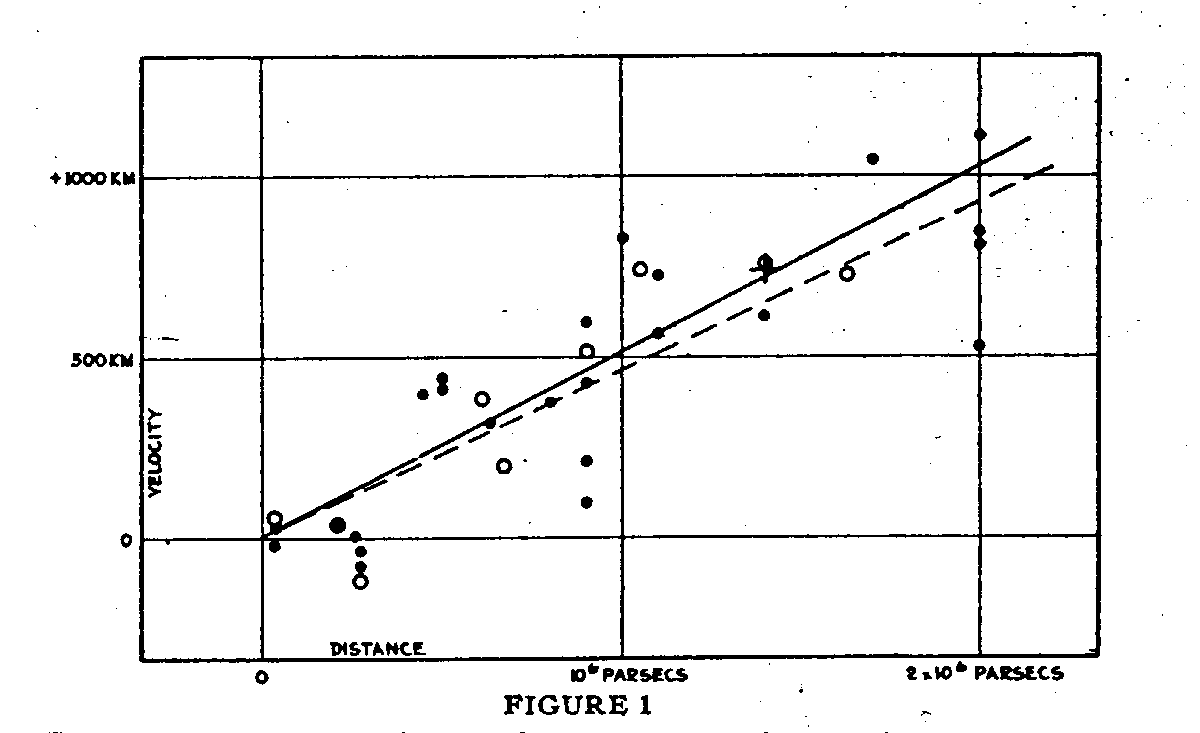[/caption]
“The distance to objects beyond the Local Group is closely related to how fast they seem to be receding from us,” that’s Hubble’s law in a nutshell.
Edwin Hubble, the astronomer the Hubble Space Telescope is named after, first described the relationship which later bore his name in a paper in 1929; here is one of the ways he described it, in that paper: “The data in the table [of “nebulae”, i.e. galaxies] indicate a linear correlation between distances and velocities“; in numerical form, v = Hd (v is the speed at which a distant object is receding from us, d is its distance, and H is the Hubble constant).
Today the Hubble law is usually expressed as a relationship between redshift and distance, partly because redshift is what astronomers can measure directly.
Hubble’s Law, which is an empirical relationship, was the first concrete evidence that Einstein’s theory of General Relativity applied to the universe as a whole, as proposed only two years earlier by Georges Lemaître (interestingly, Lemaître’s paper also includes an estimate of the Hubble constant!); the universal applicability of General Relativity is the heart of the Big Bang theory, and the way we see the predicted expansion of space is as the speed at which things seem to be receding being proportional to their distance, i.e. Hubble’s Law.
Although other astronomers, such as Vesto Silpher, did much of the work needed to measure the galaxy redshifts, Hubble was the one who developed techniques for estimating the distance to the galaxies, and who pulled it all together to show how distance and speed were related.
Hubble’s Law is not exact; the measured redshift of some galaxies is different from what Hubble’s Law says it should be, given their distances. This is particularly noticeable for galaxy clusters, and is explained as the motion of galaxies within their local groups or clusters, due to their mutual gravitation.
Because the exact value of the Hubble constant, H, is so important in extragalactic astronomy and cosmology – it leads to an estimate of the age of the universe, helps test theories of Dark Matter and Dark Energy, and much more – a great deal of effort has gone into working it out. Today it is estimated to be 71 kilometers per second per megaparsec, plus or minus 7; this is about 21 km/sec per million light-years. What does this mean? An object a million light-years away would be receding from us at 21 km/sec; an object 10 million light-years away, 210 km/sec, etc.
Perhaps the most dramatic revision to the Hubble Law came in 1998, when two teams independently announced that they’d discovered that the rate of expansion of the universe is accelerating; the shorthand name for this observation is Dark Energy.
Harvard University’s Professor of Cosmology John Huchra maintains a webpage on the history of the Hubble constant, and this page from Ned Wright’s Cosmology Tutorial explains how the Hubble law and cosmology are related.
There are several Universe Today stories about the Hubble relationship and the Hubble constant; for example Astronomers Closing in on Dark Energy with Refined Hubble Constant, and Cosmologists Improve on Standard Candles Measurement.
And we have done some Astronomy Casts on it too, How Old is the Universe? and, How Big is the Universe?
Sources:
UT-Knoxville
NASA
Cornell Astronomy

